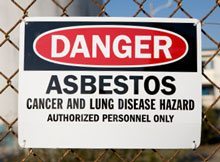Surgery for Mesothelioma: Goals and Side Effects

Residual thoracic spaces occur in one-third of patients who receive surgery for mesothelioma. This is the space left after mesothelioma disease is removed from the lung.
A new study by researchers in Japan details the results of an analysis of this side effect.
Pleural Mesothelioma
Mesothelioma is a rare form of cancer caused by exposure to asbestos. Treatment often combines surgery, chemotherapy, and radiation.
Pleural mesothelioma is a type of cancer that develops from the thin layer of tissue that covers the lungs and chest wall. Symptoms may include shortness of breath due to fluid around the lung, chest pain, cough, and fatigue. This cancer is caused by exposure to asbestos.
It can often take around 40 years for pleural mesothelioma to begin. Imaging studies such as X-rays or CT scans may help in the diagnosis, but the disease is usually confirmed by a tissue biopsy.
Pleural mesothelioma occurs in about 2,000 people in the United States every year. Rates of pleural mesothelioma vary worldwide and are highest in Australia and the United Kingdom. The disease occurs more often in men than women. Diagnosis typically occurs in people over the age of 60, but pleural mesothelioma has occurred in people in their twenties.
Residual Thoracic Spaces after Surgery
A common surgery for mesothelioma is pleurectomy decortication. This is a procedure that removes the lining around the lung.
The goals of surgery for mesothelioma are to re-expand the lung and remove the disease. If the disease affecting the pleural space is removed, lung function and symptoms will improve.
Researchers from the Hyogo College of Medicine in Japan investigated how often residual thoracic spaces occur after surgery. They reviewed patient records from September 2012 to December 2020.
The analysis included 170 patients. They found that one-third of these patients experienced residual thoracic spaces after their surgery.
A small number of these also experienced empyema. Empyema is a collection of pus in the lung and its membrane. This is a serious condition that may need more surgery to fix.
The researchers also identified a longer postoperative air leak as a risk factor for residual thoracic spaces. This is an air leak occurring for more than seven days. Postoperative air leak increases a patient’s risk for infection, stroke, and pain.
The researchers suggest that close follow-up appointments could prevent the development of residual thoracic spaces and empyema.
Source
Nakamura A, Hashimoto M, Kondo N, Matsumoto S, Nakamichi T, Kuribayashi K, Kijima T, Kodama H, Yamakado K, Hasegawa S. Long-term Outcomes and Risk Factors of Residual Thoracic Spaces after Pleurectomy/Decortication for Mesothelioma. Eur J Cardiothorac Surg. 2022 Oct 19:ezac500. doi: 10.1093/ejcts/ezac500. Epub ahead of print. PMID: 36259940. https://pubmed.ncbi.nlm.nih.gov/36259940/





